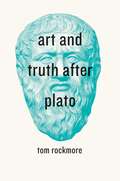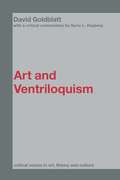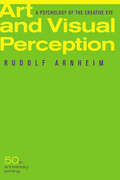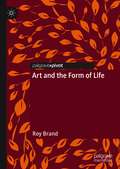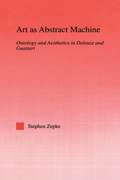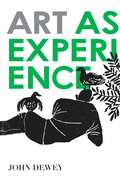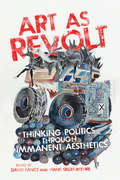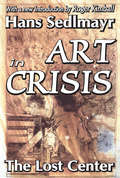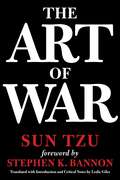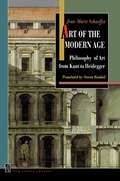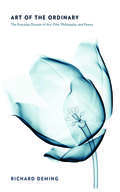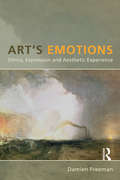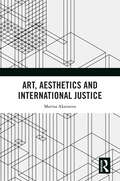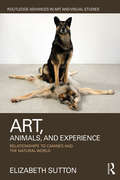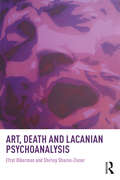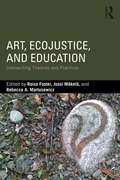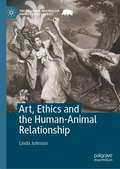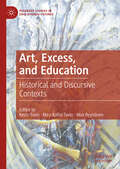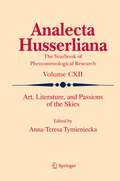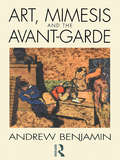- Table View
- List View
Art and Truth after Plato
by Tom RockmoreDespite its foundational role in the history of philosophy, Plato's famous argument that art does not have access to truth or knowledge is now rarely examined, in part because recent philosophers have assumed that Plato's challenge was resolved long ago. In Art and Truth after Plato, Tom Rockmore argues that Plato has in fact never been satisfactorily answered--and to demonstrate that, he offers a comprehensive account of Plato's influence through nearly the whole history of Western aesthetics. Rockmore offers a cogent reading of the post-Platonic aesthetic tradition as a series of responses to Plato's position, examining a stunning diversity of thinkers and ideas. He visits Aristotle's Poetics, the medieval Christians, Kant's Critique of Judgment, Hegel's phenomenology, Marxism, social realism, Heidegger, and many other works and thinkers, ending with a powerful synthesis that lands on four central aesthetic arguments that philosophers have debated. More than a mere history of aesthetics, Art and Truth after Plato presents a fresh look at an ancient question, bringing it into contemporary relief.
Art and Truth after Plato
by Tom RockmoreDespite its foundational role in the history of philosophy, Plato’s famous argument that art does not have access to truth or knowledge is now rarely examined, in part because recent philosophers have assumed that Plato’s challenge was resolved long ago. In Art and Truth after Plato, Tom Rockmore argues that Plato has in fact never been satisfactorily answered—and to demonstrate that, he offers a comprehensive account of Plato’s influence through nearly the whole history of Western aesthetics. Rockmore offers a cogent reading of the post-Platonic aesthetic tradition as a series of responses to Plato’s position, examining a stunning diversity of thinkers and ideas. He visits Aristotle’s Poetics, the medieval Christians, Kant’s Critique of Judgment, Hegel’s phenomenology, Marxism, social realism, Heidegger, and many other works and thinkers, ending with a powerful synthesis that lands on four central aesthetic arguments that philosophers have debated. More than a mere history of aesthetics, Art and Truth after Plato presents a fresh look at an ancient question, bringing it into contemporary relief.
Art and Ventriloquism (Critical Voices in Art, Theory and Culture)
by David GoldblattThis exciting collection of David Goldblatt's essays, available for the first time in one volume, uses the metaphor of ventriloquism to help understand a variety of art world phenomena. It examines how the vocal vacillation between ventriloquist and dummy works within the roles of artist, artwork and audience as a conveyance to the audience of the performer's intentions, emotions and beliefs through a created performative persona. Considering key works, including those of Nietzsche, Foucault, Socrates, Derrida, Cavell and Wittgenstein, Goldblatt examines how the authors use the framework of ventriloquism to construct and negate issues in art and architecture. He ponders 'self-plagiarism'; why the classic philosopher cannot speak for himself, but must voice his thoughts through fictional characters or inanimate objects and works. With a close analysis of two ventriloquist paintings by Jasper Johns and Paul Klee, a critical commentary by Garry L. Hagberg, and preface by series editor Saul Ostrow, Goldblatt's thoroughly fascinating book will be an invaluable asset to students of cultural studies, art, and philosophy.
Art and Visual Perception, Second Edition: A Psychology of the Creative Eye
by Rudolf ArnheimSince its publication fifty years ago, this work has established itself as a classic. It casts the visual process in psychological terms and describes the creative way one's eye organizes visual material according to specific psychological premises. In 1974 this book was revised and expanded, and since then it has continued to burnish Rudolf Arnheim's reputation as a groundbreaking theoretician in the fields of art and psychology.
Art and the Church: Ecclesiastical Encounters with Contemporary Art
by Jonathan Koestle-CateA vibrant critical exchange between contemporary art and Christianity is being increasingly prompted by an expanding programme of art installations and commissions for ecclesiastical spaces. Rather than 'religious art' reflecting Christian ideology, current practices frequently initiate projects that question the values and traditions of the host space, or present objects and events that challenge its visual conventions. In the light of these developments, this book asks what conditions are favourable to enhancing and expanding the possibilities of church-based art, and how can these conditions be addressed? What viable language or strategies can be formulated to understand and analyse art's role within the church? Focusing on concepts drawn from anthropology, comparative religion, art theory, theology and philosophy, this book formulates a lexicon of terms built around the notion of encounter in order to review the effective uses and experience of contemporary art in churches. The author concludes with the prognosis that art for the church has reached a critical and decisive phase in its history, testing the assumption that contemporary art should be a taken-for-granted element of modern church life. Art and the Church: A Fractious Embrace uniquely combines conceptual analysis, critical case studies and practical application in a rigorous and inventive manner, dealing specifically with contemporary art of the past twenty-five years, and the most recent developments in the church's policies for the arts.
Art and the Form of Life
by Roy BrandArt and the Form of Life takes a classic theme—philosophy as the art of living—and gives it a contemporary twist. The book examines a series of watershed moments in artistic practice alongside philosophers’ most enduring questions about the way we live. Coupling Tino Sehgal with Wittgenstein, cave art with Foucault, Stanley Kubrick with Nietzsche, and the Bauhaus with Walter Benjamin, the book animates the idea that life is literally ours to make. It reflects on universal themes that connect the long histories of art and philosophy, and it does so using a contemporary approach. Drawing on great philosophical works, it argues that life practiced as an art form affords an experience of meaning, in the sense that it is engaging, creative, and participatory. It thus effects a fundamental renewal of experience.
Art as Abstract Machine: Ontology and Aesthetics in Deleuze and Guattari
by Stephen ZepkeFirst Published in 2005. Routledge is an imprint of Taylor & Francis, an informa company.
Art as Experience
by John DeweyBased on John Dewey's lectures on esthetics, delivered as the first William James Lecturer at Harvard in 1932, Art as Experience has grown to be considered internationally as the most distinguished work ever written by an American on the formal structure and characteristic effects of all the arts: architecture, sculpture, painting, music, and literature.
Art as Revolt: Thinking Politics through Immanent Aesthetics
by Hans Skott-Myhre David FancyHow can we imagine a future not driven by capitalist assumptions about humans and the wider world? How are a range of contemporary artistic and popular cultural practices already providing pathways to post-capitalist futures? Authors from a variety of disciplines answer these questions through writings on blues and hip hop, virtual reality, post-colonial science fiction, virtual gaming, riot grrrls and punk, raku pottery, post-pornography fanzines, zombie films, and role playing. The essays in Art as Revolt are clustered around themes such as technology and the future, aesthetics and resistance, and ethnographies of the self beyond traditional understandings of identity. Using philosophies of immanence – describing a system that gives rise to itself, independent of outside forces – drawn from a rich and evolving tradition that includes Spinoza, Nietzsche, Deleuze, and Braidotti, the authors and editors provide an engrossing range of analysis and speculation. Together the essays, written by experts in their fields, stage an important collective, transdisciplinary conversation about how best to talk about art and politics today. Sophisticated in its theoretical and philosophical premises, and engaging some of the most pressing questions in cultural studies and artistic practice today, Art as Revolt does not provide comfortable closure. Instead, it is understood by its authors to be a “Dionysian machine,” a generator of open-ended possibility and potential that challenges readers to affirm their own belief in the futures of this world. Contributors include Timothy J. Beck (University of West Georgia) Mark Bishop (Independent Scholar), Dave Collins (University of West Georgia), David Fancy (Brock University), Veronica Pacini-Ketchabaw (University of Western Ontario), Malisa Kurtz (Independent Scholar), Nicole Land (Ryerson University), Eric Lochhead (Youth Author Calgary Alberta) , Douglas Ord (Doctoral Student University of Western Ontario), Peter Rehberg (Institute for Cultural Inquiry—Berlin), Chris Richardson (Young Harris College), Hans Skott-Myhre (Kennesaw State University), Kathleen Skott-Myhre (University of West Georgia), and Joanna Wasiak (Independent Scholar).
Art as Revolt: Thinking Politics through Immanent Aesthetics
by David Fancy and Hans Skott-MyhreHow can we imagine a future not driven by capitalist assumptions about humans and the wider world? How are a range of contemporary artistic and popular cultural practices already providing pathways to post-capitalist futures? Authors from a variety of disciplines answer these questions through writings on blues and hip hop, virtual reality, post-colonial science fiction, virtual gaming, riot grrrls and punk, raku pottery, post-pornography fanzines, zombie films, and role playing. The essays in Art as Revolt are clustered around themes such as technology and the future, aesthetics and resistance, and ethnographies of the self beyond traditional understandings of identity. Using philosophies of immanence – describing a system that gives rise to itself, independent of outside forces – drawn from a rich and evolving tradition that includes Spinoza, Nietzsche, Deleuze, and Braidotti, the authors and editors provide an engrossing range of analysis and speculation. Together the essays, written by experts in their fields, stage an important collective, transdisciplinary conversation about how best to talk about art and politics today. Sophisticated in its theoretical and philosophical premises, and engaging some of the most pressing questions in cultural studies and artistic practice today, Art as Revolt does not provide comfortable closure. Instead, it is understood by its authors to be a “Dionysian machine,” a generator of open-ended possibility and potential that challenges readers to affirm their own belief in the futures of this world. Contributors include Timothy J. Beck (University of West Georgia), Mark Bishop (Independent Scholar), Dave Collins (University of West Georgia), David Fancy (Brock University), Veronica Pacini-Ketchabaw (University of Western Ontario), Malisa Kurtz (Independent Scholar), Nicole Land (Ryerson University), Eric Lochhead (Youth Author Calgary Alberta), Douglas Ord (Doctoral Student University of Western Ontario), Joanna Perkins (Independent Scholar), Peter Rehberg (Institute for Cultural Inquiry—Berlin), Chris Richardson (Young Harris College), Hans Skott-Myhre (Kennesaw State University), and Kathleen Skott-Myhre (University of West Georgia).
Art before the Law
by Ruth RonenEver since Plato expelled the poets from his ideal state, the ethics of art has had to confront philosophy's denial of art's morality. In Art before the Law, Ruth Ronen proposes a new outlook on the ethics of art by arguing that art insists on this tradition of denial, affirming its singular ethics through negativity.Ronen treats the mechanism of negation as the basis for the relationship between art and ethics. She shows how, through moves of denial, resistance, and denouncement, art exploits its negative relation to morality. While deception, fiction, and transgression allegedly locate art outside morality and ethics, Ronen argues they enable art to reveal the significance of the moral law, its origins, and the idea of the good. By employing the thought of Freud and Lacan, Ronen reconsiders the aesthetic tradition from Plato through Kant and later philosophers of art in order to establish an ethics of art. An interdisciplinary study, Art before the Law is sure to be of interest both to academic philosophers and to those interested in psychoanalytic theory and practice.
Art in Crisis: The Lost Center
by Hans SedlmayrThe history of art from the early nineteenth century on- ward is commonly viewed as a succession of conflicts between innovatory and established styles that culminated in the formalism and aesthetic autonomy of high modernism. In Art and Crisis, first published in 1948, Hans Sedlmayr argues that the aesthetic disjunctures of modern art signify more than matters of style and point to much deeper processes of cultural and religious disintegration. As Roger Kimball observes in his informative new introduction, Art in Crisis is as much an exercise in cultural or spiritual analysis as it is a work of art history. Sedlmayr's reads the art of the last two centuries as a fever chart of the modern age in its greatness and its decay. He discusses the advent of Romanticism with its freeing of the imagination as a conscious sundering of art from humanist and religious traditions with the aesthetic treated as a category independent of human need. Looking at the social purposes of architecture, Sedlmayr shows how the landscape garden, the architectural monument, and the industrial exhibition testified to a new relationship not only between man and his handiwork but also between man and the forces that transcend him. In these institutions man deifies his inventive powers with which he hopes to master and supersede nature. Likewise, the art museum denies transcendence through a cultural leveling in which Heracles and Christ become brothers as objects of aesthetic contemplation. At the center of Art in Crisis is the insight that, in art as in life, the pursuit of unqualified autonomy is in the end a prescription for disaster, aesthetic as well as existential. Sedlmayr writes as an Augustinian Catholic. For him, the underlying motive for the pursuit of autonomy is pride. The lost center of his subtitle is God. The dream of autonomy, Sedlmayr argues, is for finite, mortal creatures, a dangerous illusion. The book invites serious analysis from art cri
Art of War
by Sun Tzu&“The art of war is of vital importance to the State. It is a matter of life and death, a road either to safety or to ruin. Hence it is a subject of inquiry which can on no account be neglected.&” There is a reason why five-star generals and Fortune 500 CEOs alike have consulted this classic book on the planning and conduct of military operations. Written in China more than two thousand years ago, The Art of War is an ancient Chinese military treatise attributed to Sun Tzu, a high-ranking military general, strategist, and tactician. The Art of War remains one of the most quoted and referenced how-to books ever written. Now, with a foreword by Stephen K. Bannon, this seminal work takes on renewed significance, offering a blueprint for success amidst the chaos of contemporary challenges. As we navigate the complexities of the twenty-first century, The Art of War stands as a beacon of strategic wisdom, guiding us through the turbulent waters of life, leadership, and conflict. Its profound truths, encapsulated in thirteen timeless chapters, illuminate the path to victory in any arena, whether it be the cutthroat world of business, the arena of politics, or the theater of war.
Art of the Modern Age: Philosophy of Art from Kant to Heidegger (New French Thought Series #2)
by Jean-Marie SchaefferThis is a sweeping and provocative work of aesthetic theory: a trenchant critique of the philosophy of art as it developed from the eighteenth century to the early twentieth century, combined with a carefully reasoned plea for a new and more flexible approach to art.Jean-Marie Schaeffer, one of France's leading aestheticians, explores the writings of Kant, Schlegel, Novalis, Hegel, Schopenhauer, Nietzsche, and Heidegger to show that these diverse thinkers shared a common approach to art, which he calls the "speculative theory." According to this theory, art offers a special kind of intuitive, quasi-mystical knowledge, radically different from the rational knowledge acquired by science. This view encouraged theorists to consider artistic geniuses the high-priests of humanity, creators of works that reveal the invisible essence of the world. Philosophers came to regard inexpressibility as the aim of art, refused to consider second-tier creations genuine art, and helped to create conditions in which the genius was expected to shock, puzzle, and mystify the public. Schaeffer shows that this speculative theory helped give birth to romanticism, modernism, and the avant-garde, and paved the way for an unfortunate divorce between art and enjoyment, between "high art" and popular art, and between artists and their public.Rejecting the speculative approach, Schaeffer concludes by defending a more tolerant theory of art that gives pleasure its due, includes popular art, tolerates less successful works, and accounts for personal tastes."[A] remarkable work.... [Schaeffer's] writing is governed by ... the ideals of clarity and consequence, the ideas of logic, truth, and evidence.... Schaeffer is so precise and unrelenting a philosophical critic that one wonders how some of the philosophies he anatomizes here can possibly survive the operation."--From the foreword by Arthur C. Danto
Art of the Ordinary: The Everyday Domain of Art, Film, Philosophy, and Poetry
by Richard DemingCutting across literature, film, art, and philosophy, Art of the Ordinary is a trailblazing, cross-disciplinary engagement with the ordinary and the everyday. Because, writes Richard Deming, the ordinary is always at hand, it is, in fact, too familiar for us to perceive it and become fully aware of it. The ordinary he argues, is what most needs to be discovered and yet is something that can never be approached, since to do so is to immediately change it.Art of the Ordinary explores how philosophical questions can be revealed in surprising places—as in a stand-up comic’s routine, for instance, or a Brillo box, or a Hollywood movie. From negotiations with the primary materials of culture and community, ways of reading "self" and "other" are made available, deepening one’s ability to respond to ethical, social, and political dilemmas. Deming picks out key figures, such as the philosophers Stanley Cavell, Arthur Danto, and Richard Wollheim; poet John Ashbery; artist Andy Warhol; and comedian Steven Wright, to showcase the foundational concepts of language, ethics, and society. Deming interrogates how acts of the imagination by these people, and others, become the means for transforming the alienated ordinary into a presence of the everyday that constantly and continually creates opportunities of investment in its calls on interpretive faculties.In Art of the Ordinary, Deming brings together the arts, philosophy, and psychology in new and compelling ways so as to offer generative, provocative insights into how we think and represent the world to others as well as to ourselves.
Art's Emotions: Ethics, Expression and Aesthetic Experience
by Damien FreemanDespite the very obvious differences between looking at Manet’s Woman with a Parrot and listening to Elgar’s Cello Concerto, both experiences provoke similar questions in the thoughtful aesthete: why does the painting seem to express reverie and the music, nostalgia? How do we experience the reverie and nostalgia in such works of art? Why do we find these experiences rewarding in similar ways? As our awareness of emotion in art, and our engagement with art’s emotions, can make such a special contribution to our life, it is timely for a philosopher to seek to account for the nature and significance of the experience of art’s emotions. Damien Freeman develops a new theory of emotion that is suitable for resolving key questions in aesthetics. He then reviews and evaluates three existing approaches to artistic expression, and proposes a new approach to the emotional experience of art that draws on the strengths of the existing approaches. Finally, he seeks to establish the ethical significance of this emotional experience of art for human flourishing. Freeman challenges the reader not only to consider how art engages with emotion, but how we should connect up our answers to questions concerning the nature and value of the experiences offered by works of art.
Art, Aesthetics and International Justice
by Marina AksenovaThis book demonstrates that art is implicit in the process of administration of international justice. The diverse nature of recent global threats as well as an overwhelming pull towards isolationism and nationalism challenge the dominant deterrence paradigm of international governance created in the aftermath of the Second World War. An alternative model is to focus on cooperation, and not deterrence, as a guiding operational principle.This volume focuses on the theoretical component linking justice with aesthetics as well as on the practical manifestation of such connection evident, inter alia, in the rhetoric of international courts, their architectural design and their commemorative practices expressed by the practice of symbolic reparations adopted by some of the courts. The underlying premise of the book is that international justice requires new vocabulary and new approaches, which can be derived from the study of aesthetics. It is held that exploring the aesthetical dimension of international justice contributes to the discussion on the foundations of its authority and the grounds for compliance with it. The work engages deeply with the theory of aesthetics developed by Immanuel Kant and Abhinavagupta, a Kashmiri critic, philosopher and scholar writing in the early eleventh century.The book will be of interest to academics and researchers working in the areas of Legal Philosophy, International Criminal Justice and International Law and International Relations.
Art, Animals, and Experience: Relationships to Canines and the Natural World (Routledge Advances in Art and Visual Studies)
by Elizabeth SuttonElizabeth Sutton, using a phenomenological approach, investigates how animals in art invite viewers to contemplate human relationships to the natural world. Using Rembrandt van Rijn’s etching of The Presentation in the Temple (c. 1640), Joseph Beuys’s social sculpture I Like America and America Likes Me (1974), archaic rock paintings at Horseshoe Canyon, Canyonlands National Park, and examples from contemporary art, this book demonstrates how artists across time and cultures employed animals to draw attention to the sensory experience of the composition and reflect upon the shared sensory awareness of the world.
Art, Death and Lacanian Psychoanalysis
by Efrat Biberman Shirley Sharon-ZisserArt, Death and Lacanian Psychoanalysis examines the relationship between art and death from the perspective of Lacanian psychoanalysis. It takes a unique approach to the topic by making explicit reference to the death drive as manifest in theories of art and in artworks. Freud’s treatment of death focuses not on the moment of biological extinction but on the recurrent moments in life which he called "the death drive" or the "compulsion to repeat": the return precisely of what is most unbearable for the subject. Surprisingly, in some of its manifestations, this painful repetition turns out to be invigorating. It is this invigorating repetition that is the main concern of this book, which demonstrates the presence of its manifestations in painting and literature and in the theoretical discourse concerning them from the dawn of Western culture to the present. After unfolding the psychoanalytical and philosophical underpinnings for the return of the death drive as invigorating repetition in the sphere of the arts, the authors examine various aspects of this repetition through the works of Gerhard Richter, Jeff Wall, and contemporary Israeli artists Deganit Berest and Yitzhak Livneh, as well as through the writings of Virginia Woolf and James Joyce. First to articulate the stimulating aspect of the death drive in its relation to the arts and the conception of art as a varied repetition beyond a limit, Art, Death and Lacanian Psychoanalysis will be indispensable to psychoanalysts, scholars of art theory and aesthetics and those studying at the intersection of art and psychoanalysis.
Art, EcoJustice, and Education: Intersecting Theories and Practices
by Rebecca A. Martusewicz Raisa Foster Jussi MäkeläEmphasizing the importance of contemporary art forms in EcoJustice Education, this book examines the interconnections between social justice and ecological well-being, and the role of art to enact change in destructive systems. Artists, educators, and scholars in diverse disciplines from around the world explore the power of art to disrupt ways of thinking that are taken for granted and dominate modern discourses, including approaches to education. The EcoJustice framework presented in this book identifies three strands—cultural ecological analysis, revitalizing the commons, and enacting imagination—that help students to recognize the value in diverse ways of knowing and being, reflect on their own assumptions, and develop their critical analytic powers in relation to important problems. This distinctive collection offers educators a mix of practical resources and inspiration to expand their pedagogical practices. A Companion Website includes interactive artworks, supplemental resources, and guiding questions for students and instructors.
Art, Education, and Cultural Renewal: Essays in Reformational Philosophy
by Lambert ZuidervaartWhat good is art? What is the point of a university education? Can philosophers contribute anything to social liberation? Such questions, both ancient and urgent, are the pulse of reformational philosophy. Inspired by the vision of the Dutch religious and political leader Abraham Kuyper, reformational philosophy pursues social transformation for the common good. In this companion volume to Religion, Truth, and Social Transformation, Lambert Zuidervaart presents a socially engaged philosophy of the arts and higher education. Interacting with the ideas of leading Kuyperian thinkers such as Calvin Seerveld and Nicholas Wolterstorff, Zuidervaart shows why renewal in the arts needs to coincide with political and economic transformation. He also calls for education and research that serve the common good. Deeply rooted in reformational philosophy, his book brings a fresh and inspiring voice to current discussions of religious aesthetics and Christian scholarship. Art, Education, and Cultural Renewal is a testament to the practical and intellectual richness of a unique religious tradition, compelling in its call for social solidarity and cultural critique.
Art, Ethics and the Human-Animal Relationship (The Palgrave Macmillan Animal Ethics Series)
by Linda JohnsonThis book examines the works of major artists between the seventeenth and nineteenth centuries, as important barometers of individual and collective values toward non-human life. Once viewed as merely representational, these works can also be read as tangential or morally instrumental by way of formal analysis and critical theories. Chapter Two demonstrates the discrimination toward large and small felines in Genesis and The Book of Revelation. Chapter Three explores the cruel capture of free roaming animals and how artists depicted their furs, feathers and shells in costume as symbols of virtue and vice. Chapter Four identifies speciest beliefs between donkeys and horses. Chapter Five explores the altered Dutch kitchen spaces and disguised food animals in various culinary constructs in still life painting. Chapter Six explores the animal substances embedded in pigments. Chapter Seven examines animals in absentia-in the crafting of brushes. The book concludes with the fish paintings of William Merritt Chase whose glazing techniques demonstrate an artistic approach that honors fishes as sentient beings.
Art, Excess, and Education: Historical and Discursive Contexts (Palgrave Studies in Educational Futures)
by Kevin Tavin Mira Kallio-Tavin Max RyynänenThis book concentrates on the deep historical, political, and institutional relationships between art, education, and excess. Going beyond field specific discourses of art history, art criticism, philosophy, and aesthetics, it explores how the concept of excess has been important and enduring from antiquity through contemporary art, and from early film through the newer interactive media. Examples considered throughout the book focus on disgust, grandiosity, sex, violence, horror, disfigurement, endurance, shock, abundance, and emptiness, and frames them all within an educational context. Together they provide theories and classificatory systems, historical and political interpretations of art and excess, examples of popular culture, and suggestions for the future of educational practice.
Art, Literature, and Passions of the Skies: Art, Literature, And Passions Of The Skies (Analecta Husserliana #112)
by Anna Teresa TymienieckaFlashes of lightning, resounding thunder, gloomy fog, brilliant sunshine...these are the life manifestations of the skies. The concrete visceral experiences that living under those skies stir within us are the ground for individual impulses, emotions, sentiments that in their interaction generate their own ever-changing clouds. While our intellect concentrates on the discovery of our cosmic position, on the architecture of the universe, our imagination is informed by the gloomy vapors, the glimmers of fleeting light, and the glory of the skies. Reconnoitering from the soil of human life and striving towards the infinite, the elan of imagination gets caught up in the clouds of the skies. There in that dimness, sensory receptivity, dispositions, emotions, passionate strivings, yearnings, elevations gather and propagate. From the "Passions of the Skies" spring innermost intuitions that nourish literature and the arts.
Art, Mimesis and the Avant-Garde: Aspects of a Philosophy of Difference
by Andrew BenjaminFirst published in 1991. Routledge is an imprint of Taylor & Francis, an informa company.
